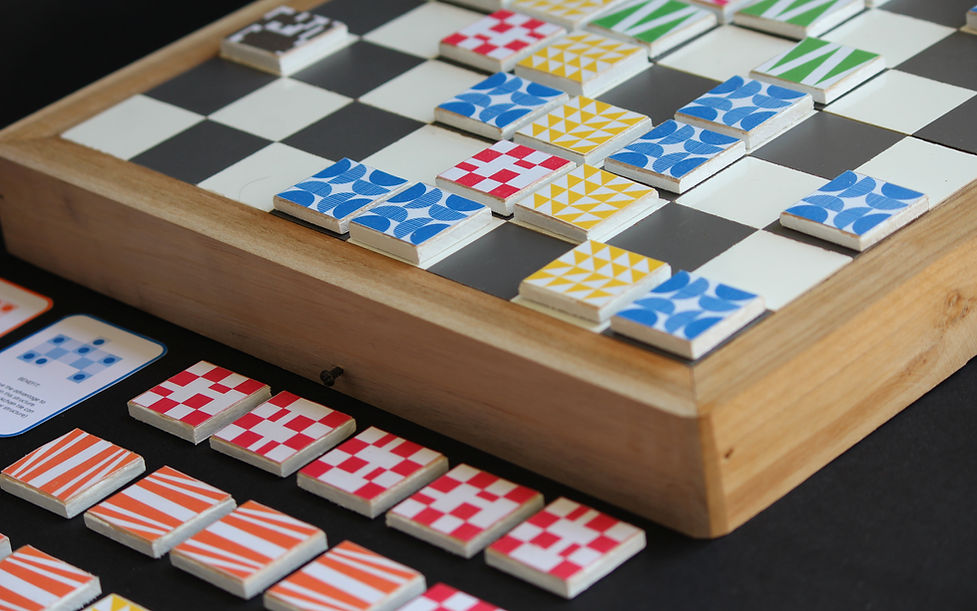OSOBA
OSOBA is a unique and engaging 2-player game designed to delve into the psychology of its players. The objective of this game is reveal the player's personality and character traits via shapes and colours.

DURATION
Research and Psychology
(2 weeks)
Game & Strategy Design
(3 weeks)
MODULE
Design Project, 2020
Semester 4
TOOLS
Adobe Illustrator
SKILLS
Sketching
Strategy Building
Level Layout
Game Design
Architecture
.jpg)
ABOUT
OSOBA is a game that emphasizes the visual arrangement of shapes. It is a 2-player game, which includes assembling the wooden tiles in a specific structure as shown in the structure card. Every shape and colour has a meaning attached to it, influencing our minds and reacting differently. This game is a way to find each other's personality and skills based on strategic thinking, while having fun with making patterns at the same time.
GAMEPLAY MECHANICS
The game altogether counts 40 points (10 points for every structure card). Three special black tiles are introduced to make the game more interesting (3 tiles to each player).
Stage 1
Setup: Each player is given 4 sets of coloured tiles to choose from. Each colour has 8 tiles, making a total of 32 tiles per player. These tiles are associated with different personality traits and characteristics.
Stage 2
Scenarios: The game presents various patterns as challenges that require players to use their structure in specific ways. Each player has to pick 4 structure cards aligning to the chosen coloured tiles. Every card has a benefit mentioned on it.
These structures are crafted to test different aspects of personality, such as creativity, logic, and emotional intelligence.
Stage 3
Turns: Players take turns selecting tiles to place on a game board. The placement and combination of these elements are crucial and are designed to reflect the player’s strategic thinking and personality. At this point, it is advised to refer the rule card included in the game kit.
Stage 4
Analysis: As the game progresses to its last step, the opponents colours from the personality card is to be chosen, leading it to an interactive session and building a friendly connection.
The choices made by each player are analysed to reveal underlying personality traits using these personality cards.
DISTINCTIVE GOAL
The primary goal is to analyse the opponent's personality trait while choosing the tiles. The challenges given in the structure card not only encourages every player to make strategic choices but also to think creativity, have fun with shapes and colours and build connection with the opponent in a healthy environment .

RESEARCH INSIGHTS
Shapes and Their Meanings
-
Circles: Often associated with harmony, unity, and completeness. People who prefer circles might value community and relationships.
-
Squares: Represent stability, order, and reliability. A preference for squares might indicate a person who values structure and organization.
-
Triangles: Symbolize direction, ambition, and change. Those who choose triangles might be seen as dynamic and goal-oriented.
Colors and Their Meanings
-
Red: Associated with energy, passion, and action. People who prefer red might be seen as bold and enthusiastic.
-
Blue: Represents calmness, trust, and intelligence. A preference for blue might indicate a person who values peace and reliability.
-
Green: Linked to growth, balance, and nature. Those who choose green might be seen as nurturing and balanced.
-
Yellow: Symbolizes happiness, optimism, and creativity. A preference for yellow might suggest a person who is cheerful and imaginative.
-
Purple: Associated with luxury, wisdom, and spirituality. People who prefer purple might be seen as introspective and sophisticated.
ELEMENTS
Games typically consist of rules, objectives, and challenges that engage players. Including elements like strategy and techniques, a combination of key elements make a game like OSOBA interesting and informative at the same time.




THE RULE CARD
Rules are essential in any game as they ensure fair play, safety, and structure. They provide a consistent framework that defines how the game is played, making it enjoyable and competitive for everyone involved.

Introductory game card for players to understand multiple scenarios



PSYCHOLOGICAL FRAMEWORK
-
Color Psychology: Studies how colors affect human behavior and emotions.
-
Shape Psychology: Explores how different shapes can influence perception and personality.
DESIGN AND DEVELOPMENT
-
Visual Appeal: The game is designed to be visually appealing with a variety of shapes and vibrant colors to engage players.
-
User-Friendly: The rules are simple and easy to understand, making it accessible to a wide audience.
-
Freedom of Choice: The players can choose their colours with different sets of shapes and scenarios to keep it fresh and interesting.
SCOPE & APPLICATION
-
Educational Tool: OSOBA can be used in educational settings to teach students about psychology and strategic thinking.
-
Team Building: Organizations can use the game for team-building exercises to help employees understand each other better and improve collaboration.
-
Therapeutic Use: Therapists might use OSOBA as a tool to help clients explore their personality traits in a non-threatening and engaging way.

CONTEXTUAL ANALYSIS
The context in which shapes and colors are chosen also matters. For instance, if a player consistently chooses calming colors in stressful scenarios, it might indicate a preference for maintaining peace and stability under pressure.
PSYCHOLOGICAL INSIGHTS
-
Personality Assessment: By the end of the game, players receive insights into their personality traits based on their choices. This can be a fun and interactive way to learn more about oneself and others.
-
Strategic Thinking: The game encourages players to think strategically, considering not only their own preferences but also predicting the choices of their opponent.
-
Interpersonal Skills: Playing OSOBA can help improve interpersonal skills as players learn to understand and anticipate the behavior of others.